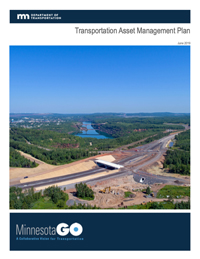Document summary: The Minnesota DOT TAMP serves as an accountability and communication tool and informs capital and operations planning efforts. In addition to being a federal requirement, the TAMP is a planning tool by which Minnesota DOT can more thoroughly evaluate risks and develop mitigation strategies, analyze life cycle costs, establish asset condition performance measures and targets, and develop investment strategies. It formalizes and documents the following key information to meet federal requirements: description and condition of pavements and bridges on the NHS; asset management objectives and measures; summary of gaps between targeted and actual performance; life cycle cost and risk management analysis; financial plan that addresses performance gaps; and investment strategies and anticipated performance.
The 2014 TAMP is available here, and the 2018 draft TAMP is also available here.
This document includes the following sections: Asset Valuation, Current Methods and Tools, Data Management, Financial Plan, Introduction, Inventory and Condition, Investment Strategies, Lifecycle Management, Objectives and Measures, Performance Assessment, Process Improvements, Risk Management.
This document meets the following additional criteria: • Asset valuation included • Defines linkages to other planning & programming documents • Future cost/performance projections are based on management system analysis (e.g. HERS, dTIMS) • Includes a review of agency roles and responsibilities for TAM • Includes cost projections for meeting performance or LOS targets • Includes estimates of future maintenance costs • Includes estimates of future rehabilitation, replacement, reconstruction, and/or renewal costs • Includes formal risk assessment results such as a risk register • Includes future projected asset condition • Includes strategies for multiple funding scenarios • Includes substantive list of process, data, and/or systems improvement actions • Investment strategies consistent with and linked to capital program • Investment strategies summarize planned capital and operating expenditures • Key revenue projection assumptions identified • Performance/LOS targets are linked to agency goals/objectives • Risk assessment results incorporated into investment strategies.
The modal scope of this document is: Highway Only.
The asset scope of this document is: Culverts,
Highway Assets,
Includes other highway assets,
Sign Supports,
Stormwater/Drainage.
External link (if available):
Direct link
